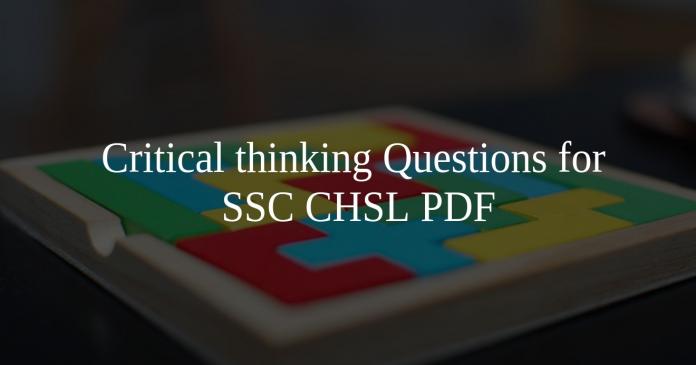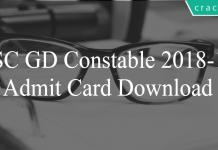Critical thinking Questions for SSC CHSL PDF
For Previous year Critical thinking Questions of SSC CHSL 2018-2019 Tier I exam download PDF. Go through the video of Repeatedly asked Critical thinking questions explanations most important for the CHSL exam.
Download Critical thinking Questions for SSC CHSL PDF
Get 200 SSC mocks for just Rs. 249. Enroll here
Take a free mock test for SSC CHSL
Download SSC CHSL Previous Papers
More SSC CHSL Important Questions and Answers PDF
Instructions
One/two statement are given, each followed by two conclusion/assumption, I and II you have to consider the statement to be true even if they seem to be at variance from commonly known facts you have to decide which of the given conclusion/assumptions. If any follows from the given statements
Question 1: Statement:
Continuous training is essential for all employees is increase their productivity
Assumptions:
1. Training is an essential component for productivity
2. Profitability & productivity are supplementary to each other
a) Only assumption II is implicit
b) Neither assumption I nor II arre implicit
c) Both assumption I and II are implicit
d) Assumption I is implicit
Question 2: Statement:
Travelling by Metro in Delhi is more convenient and economical.
Assumption:
1. Other modes of transport are not available
2. Metro services are reasonably good
a) Only Assumption I is implicit
b) Neither I nor II are implicit
c) Both I and II are implicit
d) Only Assumption II is implicit
Instructions
One/Two statements is/are given each followed by two assumption. I and II. Yes have to consider the statement to be true even if they seem to be at variance from commonly known facts. You have to decide which of the assumptions, if any, follows from the given statements.
Question 3: Statement:
“There is very heavy traffic on the road between 5-7 p.m. We need to have a flower in this area.” A planning engineer said in a meeting.
Assumption:
I-Heavy traffic should be regulated
II-Previous planning engineer did not do much about heavy traffic.
a) Only assumption I is implicit
b) Only assumption II is implicit
c) Both I & II are implicit
d) Neither I nor II are implicit
Question 4: In the question one statement is given, followed by two conclusion/assumption, I and II. You have to consider the statement to be true even if they seem to be at variance from commonly known facts. You have to decide which of the given conclusion/assumptions, if any, follows from the given statements.
Statement: An advertisement in the paper says ‘Consume pure organic boney of Company A”.
Conclusion:
I. Artificial boney can be prepared.
II. People don’t mind paying more for pure organically
a) Assumption I is implicit.
b) Both I and II are implicit
c) Neither I nor II is implicit
d) Assumption II is implicit
Question 5: Two statements are given. You have to answer considering the statement to be true. Even if they seem to be at variance from commonly known facts.
Statements:
1. James works in a factory.
2. He gets a salary.
a) James loves his work and his salary.
b) James gets paid for his work.
c) James loves his salary.
d) James likes to work in a factory.
Instructions
In the following Two questions, two statements are given each followed by two conclusions assumptions, I and II. You have to consider the statement to be true even if they seem to be at variance from commonly known facts. You have to decide which of the given conclusions/assumptions, if any, follows from the given statements.
SSC CHSL Study Material (FREE Tests)
Question 6: Statements I: The principal will address the students at 10 a.m.
II: You are requested to take your seats before 10 a.m.
Assumption I: If the student is not on his seat before 10 a.m. the function will not start.
II: The function will start as scheduled.
a) Assumption I is simplicit.
b) Both I and II are implicit.
c) Neither I nor II is implicit.
d) Assumption II is implicit.
Question 7: Statements I: Regular polygon has equal sides and equal angles.
II: Square is a regular polygon.
Conclusions I: Square has equal sides.
II: Square has equal angles.
a) Conclusions I follows.
b) Conclusions II follows.
c) Neither I nor II follows.
d) Conclusions I & II both follows.
Question 8: One statement is given followed by two conclusions/assumptions, I and II. You have to consider the statement to be true, even if it seems to be at variance from commonly known facts. You are to decide which of the given conclusions/assumptions can definitely be drawn from the given statement. Indicate your answer.
Statements:
All Hindus are God fearing. No Japanese is a Hindu.
Conclusions:
I. The Japanese are not God fearing.
II. All God fearing are Hindus.
a) Only conclusion I follows
b) Only conclusion II follows
c) Both conclusion I and conclusion II follow
d) Neither conclusion I nor conclusion II follows
Question 9: Consider the given statement/s to be true and decide which of the given conclusions/assumptions can definitely be drawn from the given statement.
Statement: To achieve economic development, people should work hard.
Conclusions: I: Economic development is directly related to people’s hardwork.
II: Working hard by all the people is impossible
a) Only I follows
b) Only II follows
c) Both I and II follow
d) Neither I nor II follows
Question 10: Consider the given statement/s to be true and decide which of the given conclusions/assumptions can definitely be drawn from the given statement.
Statement: No man is a donkey. Ajay is a man.
Conclusion:
I: Ajay is not a donkey.
II: All man are not Ajay.
a) Only conclusion I follows
b) Only conclusion II follows
c) Both conclusion I and conclusion II follow
d) Neither conclusion I nor conclusion II follows
Question 11: Consider the given statement/s to be true and decide which of the given conclusions/assumptions can definitely be drawn from the given statement.
Statement:
Ahimsa should be basic principle of human beings.
All of us should practise Ahimsa.
Conclusions:
I. We all know the real meaning of Ahimsa.
II. Ahimsa promotes global harmony.
a) only conclusion I follows
b) only conclusion II follows
c) Neither I conclusion nor II follows
d) Both conclusion I & II follow
Question 12: One statement is given followed by two conclusions/assumptions, I and II. You have to consider the statement to be true, even if it seems to be at variance from commonly known facts. You are to decide which of the given conclusions/assumptions can definitely be drawn from the given statement.
Statement:
I) Quality has a price tag.
II) India is allocating lots of funds to education.
Conclusions:
I) Quality of education in India would improve.
II) Funding alone can enhance quality of education.
a) Only Conclusion I follows
b) Only Conclusion II follows
c) Both the Conclusions I and II follow
d) Neither Conclusion I nor II follows
Question 13: One or two statements are given followed by two conclusions/assumptions, I and II. You have to consider the statement to be true, even if it seems to be at variance from commonly known facts. You are to decide which of the given conclusions/assumptions can definitely be drawn from the given statement. Indicate your answer.
Statements:
1. If people are intelligent, they should be creative.
Assumptions:
I. Creativity and intelligence are related.
II. Creative people are intelligent.
a) Only conclusion I follows
b) Only conclusion II follows
c) Both conclusion I and conclusion II follow
d) Neither conclusion I nor conclusion II follows
Question 14: Consider the given statement/s to be true and decide which of the given conclusions/assumptions can definitely be drawn from the given statement.
Statement:
Irregularity is a cause for failure in exams.
Some regular students fail in the examinations.
Conclusions:
I. All failed students are regular.
II. All successful students are not regular.
a) Only conclusion I follows
b) Only conclusion II follows
c) Both conclusion I and conclusion II follow
d) Neither conclusion I nor conclusion II follows
Question 15: Consider the given statement/s to be true and decide which of the given conclusions/assumptions can definitely be drawn from the given statement.
Statements:
a) Odisha is still an underdeveloped state.
b) Problems like poverty, unemployment and illiteracy have not been solved.
Conclusions:
I) The administration of Orissa is not sensitive enough.II) It is the Will of God.
a) Only I follows
b) Only II follows
c) Both I and II follow
d) Neither I and II follows
Answers & Solutions:
1) Answer (C)
The given statement indicates that to increase the productivity, continuous training is essential for employees. Thus, assumption I is implicit. Also, statement II is implicit as profitability & productivity are supplementary to each other. It depends upon other factors also.
Thus, both assumption I and II are implicit.
=> Ans – (C)
2) Answer (D)
The statement indicates that Delhi metro is a convenient and economical means of transport. Assumption I is not implicit as there are also other modes of transport available. Assumption II is implicit as metro services are good.
=> Ans – (D)
3) Answer (A)
The given statement indicates about the heavy traffic and that it should be controlled, hence only assumption I is implicit. Regulation of traffic is required to ensure smooth traffic. We cannot assume the plans of previous engineers.
=> Ans – (A)
4) Answer (E)
5) Answer (B)
The given statement indicates that James works in a factory and gets a salary for that. It does not mention anything about his like or dislike about his job.
Thus, only possible conclusion is that James gets paid for his work.
=> Ans – (B)
6) Answer (C)
The given statements indicate that the principal will address the students at 10 a.m. and the students are requested to take their seats before 10 a.m. This does not mean that the function will not start if the students are not on their seat, hence first assumption is not implicit. Also, it is not mandatory that the function will begin as per its original schedule.
Thus, neither I nor II is implicit.
=> Ans – (C)
7) Answer (D)
The given statement indicates that a regular polygon is the one which has equal sides and equal angles. Also, a square is a regular polygon. This means that a square must have equal sides and equal angles as concluded above.
Thus, conclusions I & II both follows.
=> Ans – (D)
8) Answer (D)
All Hindus are God fearing does not imply that all God fearing are Hindus, thus second conclusion is definitely false.
Also, no Japanese is a Hindu does not imply the the Japanese are not God fearing.
Thus, neither conclusion I nor conclusion II follows.
=> Ans – (D)
9) Answer (A)
The statement clearly indicates that people should work hard to achieve economic development, thus both of them are directly related, hence first conclusion definitely follows. But, there is no information about whether all people can work hard or not in the givens statement, hence it does not follow.
Thus, only I follows
=> Ans – (A)
10) Answer (A)
The venn diagram of the above statements is :

I: Ajay is not a donkey = true
II: All man are not Ajay = may or may not be true (when Ajay and man coincides)
Thus, only conclusion I follows
=> Ans – (A)
11) Answer (C)
The two statements infer that everyone should practise Ahimsa, but neither do they indicate its meaning and nor do they provide information about global harmony.
Thus, neither conclusion I nor II follows.
=> Ans – (C)
12) Answer (A)
If India is allocating lots of funds to education, then quality of education will definitely improve in the country, thus conclusion I follows.
From the second conclusion, we cannot conclude that funding alone can help to enhance conclusion.
Thus, only Conclusion I follows
=> Ans – (A)
13) Answer (A)
The statement indicates that, if people are intelligent, then they should be creative. So, intelligence and creativity are related with each other.
But it does not mean the reverse that creative people are intelligent.
Thus, only conclusion I follows.
=> Ans – (A)
14) Answer (D)
The given statement clearly implies that all irregular and some regular students fail in the examinations. This, in turn, means that all successful students are regular but not all regular students are successful.
Thus, neither I nor II follows.
=> Ans – (D)
15) Answer (D)
Whether the administration of Orissa is sensitive or not, it does not determine the underdeveloped condition of Orissa. Similarly, the will statements do not conclude that it is the will of God.
Thus, neither I and II follows.
=> Ans – (D)
Get 200 SSC mocks for just Rs. 249. Enroll here
Download free CAT preparation app





